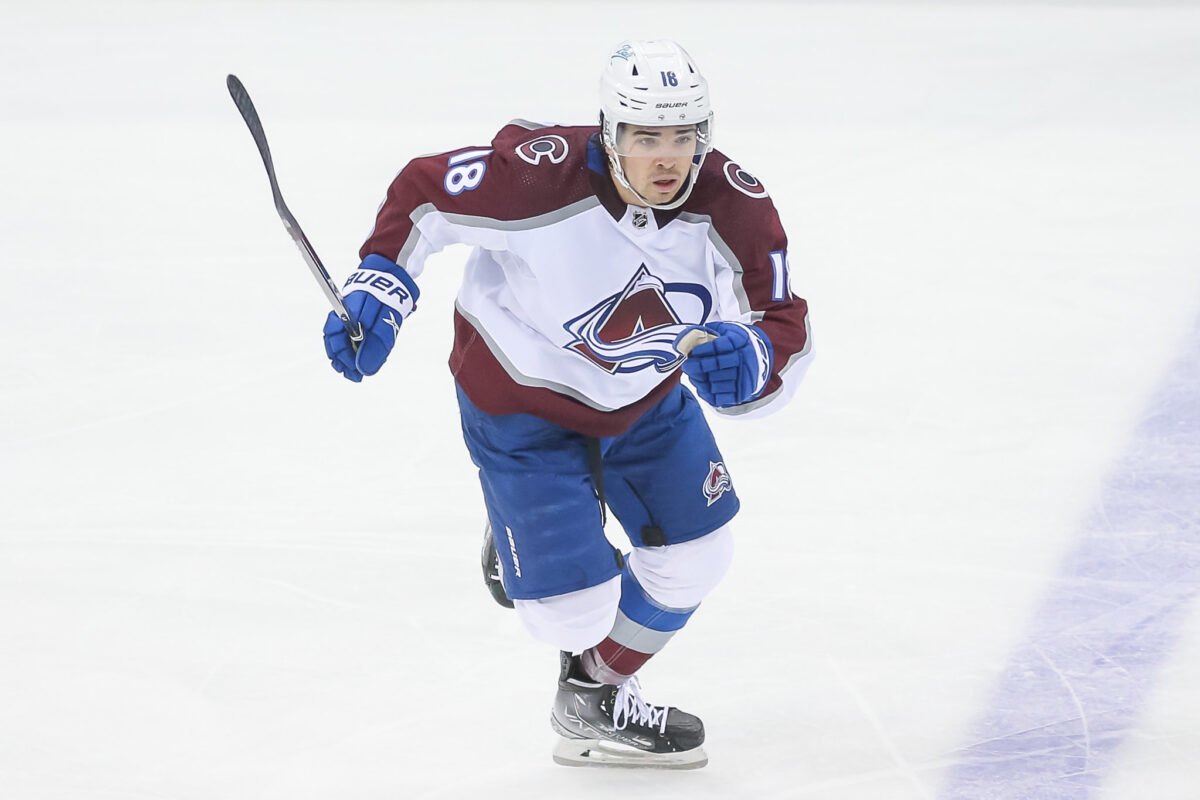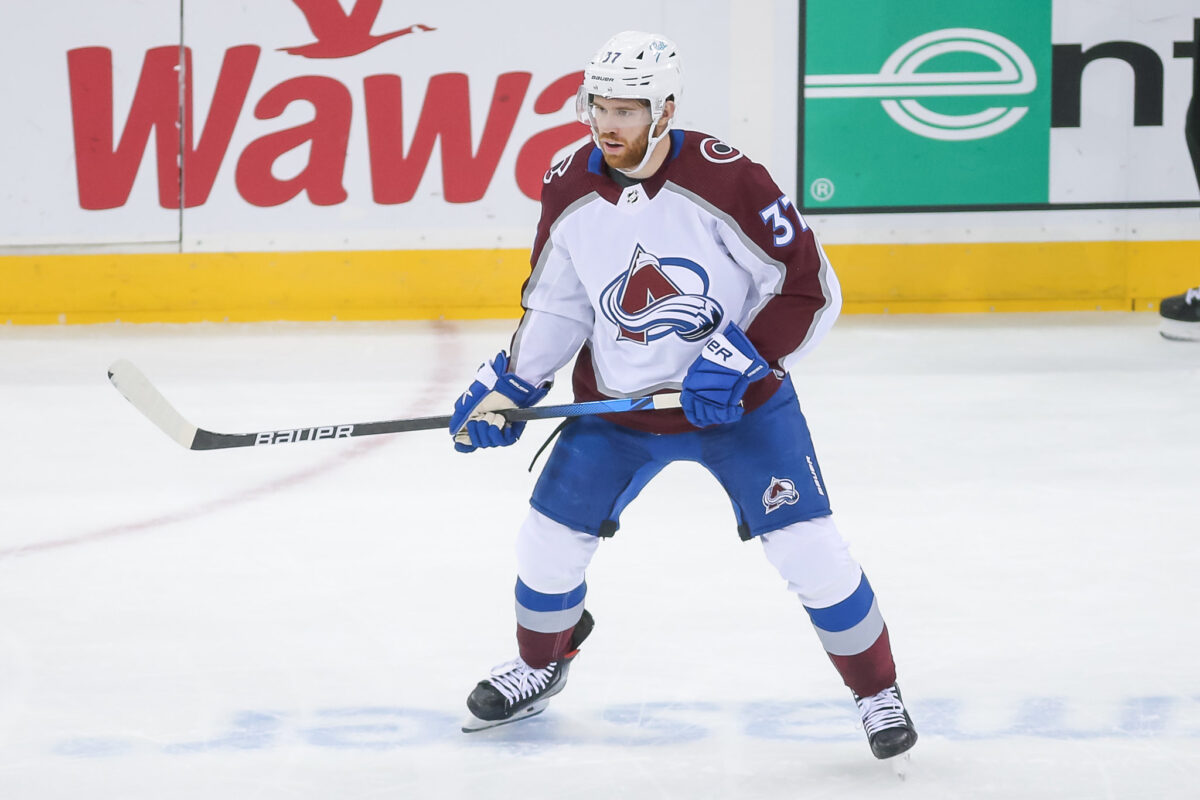Nearly two weeks into the opening of the 2022 NHL free agent period center Nazem Kadri remains on the market, yet to sign a contract with any team for the 2022-23 season. Given that the Colorado Avalanche have refrained from acquiring a replacement in a trade or inking one of the remaining free agent options, the team likely believes Kadri returning is a real possibility. Even if he decides against re-upping with the reigning Stanley Cup champions, all is not lost. The Avalanche have capable internal replacements regardless of where Kadri calls home next season, with the possible alternatives ranging from sophomore centers hoping to deliver on their potential to established stars playing out of position. With that, let’s dive in.
Alex Newhook
The first candidate is 20-year-old Alex Newhook, the likely long-term heir-apparent for Kadri’s place behind Nathan MacKinnon. He flourished in his first full NHL campaign, tallying 13 goals and 33 points in 71 games before tacking on another four assists in 12 playoff appearances. He’s been utilized in a sheltered role as a bottom-six winger to this point, with his most common forward linemates being Nicolas Aube-Kubel and Logan O’Connor at 5-on-5 last season. Regardless, he’s been advertised as a center-in-waiting since being drafted and has flashed the offensive skill required to eventually thrive in a top-six capacity.
Newhook’s 1.9 even-strength points per 60 minutes ranked 138th among all forwards (minimum 500 minutes played), representing a top-six rate when taking power-play usage out of the equation. A higher rate of secondary assists (71st among forwards) slightly inflates his totals, but his microstat profile (courtesy of Corey Sznajder’s tracking data) suggests his playstyle aligns perfectly with the Avalanche’s high-octane offensive strategy.

Newhook ranked fourth on the Avalanche by the percentage of zone entries he completed with possession of the puck, as well as the number of entries per 60 that led to a scoring chance. He also showed the ability to wriggle into dangerous areas by generating an above-average rate of shots in and around the slot, as well as shots off of one-timers and deflections. He’s yet to manage a heavy workload in transitioning the puck and functioning as a focal point of the offense, but there are inklings of a burgeoning star-in-the-making.
As is the case with many young players who make the NHL on the basis of their offensive skill, Newhook must work on the defensive side of his game to truly cement his place higher up in the lineup. With him on the ice at 5-on-5, the Avalanche controlled 49.5 percent of shots (SF%), 49.2 percent of expected goals (xGF%), and 51.2 percent of scoring chances (SCF%). Those are respectable results, and game-breaking talent can make up for defensive deficiencies, but those came in a less demanding role at both ends of the ice, where he played just under 12 minutes at 5-on-5 per night.
Further, Newhook only won 34.7 percent of his faceoffs last season, ranking 177th out of 180 players to have taken at least 200 draws. Weakness in the faceoff dot isn’t out of the ordinary for players breaking into the league. For reference, eight of the bottom 10 have completed three or fewer full NHL campaigns, including blossoming stars in Jack Hughes, Trevor Zegras, and Tim Stützle. Its a clear area of improvement for a growing talent looking to take the next step in his development.
The Avalanche likely recognize that committing to Newhook as a center in the top-six next season brings growing pains, but that is unavoidable if the team’s long-term prosperity is a priority. Winning the Stanley Cup eases some of the pressure the organization might have felt if they entered the 2022-23 campaign on the heels of yet another playoff failure. It gives the young center more freedom and leeway to grow into his role as he becomes more accustomed to the demands and rigors associated with playing center in the NHL. That he tallied nine points in 13 games to end the regular season is a good sign for his future. Replacing Kadri with Newhook might not be the most alluring option, but sometimes the right decision is the one staring you in the face.
J.T. Compher
Another capable option — if he’s not part of a trade for Kadri’s replacement — is utility-man J.T. Compher, whose versatility has seen him line up at all three positions across the forward line. His strong showing in the 2022 playoffs (eight points in 20 games) boosted his market value around the league, but the Avalanche could keep him as the second-line center given that he showed he was capable of spot-duty in that slot if required.

Unfortunately, Compher’s shot- and scoring chance-share at 5-on-5 is a real deterrent to promoting him to a full-time role on the second line. His possession numbers last season hovered in the mid- to high-40 percent range, and his high shooting percentage (SH%) of 17.7 percent doesn’t lend confidence to the idea that his scoring (18 goals in 2021-22) is sustainable in the long term.
You may also like:
- Colorado Avalanche Won’t Be Contenders This Season
- Colorado Avalanche Lineup Projection for 2024-25
- Avalanche Giving Nikolai Kovalenko a Chance to Prove Himself
- 3 Avalanche Players With the Most to Prove in 2024-25
- Peter “Foppa” Forsberg: A Biography
In addition, Compher’s microstats don’t paint him as a reliable transition player or shot generator, and the team might find more value by investing his $3.5 million salary elsewhere. There is the potential to overcome his flaws by insulating him with the likes of Valeri Nichushkin or Artturi Lehkonen — two of the NHL’s best defensive forwards — but it seems like either finding a true top-six center or elevating Newhook is a better use of the team’s resources.
Kadri’s final decision has ramifications for many players’ futures, but particularly for Compher in Colorado. Even if Kadri signs elsewhere but Newhook emerges as a legitimate top-six center next season, the 27-year-old’s time in Denver could quickly draw to a close. Of the three avenues to move past a potential Kadri exit presented in this article, this is the one I find least compelling.
Mikko Rantanen
The third and final option is to move power forward Mikko Rantanen from his traditional spot on the wing and slide him over into the middle of the ice. My line of thinking is that as hockey moves closer to a positionless sport, a player’s on-ice designation should become less significant when constructing forward lines, for example. If each skater can interchange at will, it becomes less important to have a recognized center on the ice at all times. It helps that Rantanen occasionally played center throughout the Avalanche’s Cup run, already giving him some familiarity with the demands of the position.

Rantanen is more than capable of generating offensive opportunities while not conceding a high rate of shots or scoring chances. When you have the puck as often as he does, playing defence is such a rare occurrence that it almost doesn’t matter (to an extent) how strong a defensive player is in the traditional sense of being physically overpowering. For what it’s worth, the Finnish forward also completed 42 takeaways at even strength last season, ranking 41st among all forwards.
Rantanen also took 289 faceoffs at 5-on-5 last season, winning 46 percent of his draws. It’s not an elite win-rate (Patrice Bergeron won over 63 percent), but it’s a serviceable ratio that can be overcome during the run of play. Research shows that winning faceoffs may not matter as much as the general public would like to believe, which should shift the desire to stuff one’s lineup with faceoff aces who don’t contribute much of anything else.
| Statistic | 5v5 Per-60 Rate | NHL Rank |
|---|---|---|
| Unblocked Shots Against | 40.4 | 134 |
| Chances Against | 24.8 | 62 |
| Expected Goals Against | 2.31 | 99 |
If that fails to assuage your fears, Rantanen is likely to skate alongside one or more of Gabriel Landeskog, Nichushkin, or Lehkonen, several of the top defensive wingers in the NHL. It doesn’t matter where the defensive presence comes from — winger Mark Stone is a perennial Selke Trophy candidate — and its absence can be mitigated by always controlling the puck.
Fans and analysts alike misconstrue a lack of physicality or size for defensive deficiency, but that shouldn’t be the case. At its core, defense is about keeping the puck away from the net and not surrendering high-danger scoring chances, and how it comes about should not and does not matter. Whether it’s through physically dominating an opposing player or maintaining possession of the puck for the entire shift, the method is not important as long as it gets the job done.
Still, sticking Rantanen at center might not be the best use of his skills. He can use his massive frame to win board battles and capitalize on the space he’s given on the wing to manufacture higher-quality shot attempts. Even so, it pays to have options, and the Avalanche have the evidence such a position switch can reap favourable results, which affords them greater lineup flexibility.
Avalanche Have Capable Internal Options to Replace Kadri
Kadri’s impact during the 2021-22 season should not be understated. While the Avalanche battled a rash of injuries and absences to start the campaign, the veteran pivot delivered the best season of his career, reaching peak production in almost every statistical category. Nevertheless, his age profile and likely high contract ask could drive him out of Colorado, especially as the organization has several blossoming stars in need of raises over the next two seasons.
Fortunately for the Avalanche, they boast a number of players who could slide into the second-line center role and post adequate results in the process. Although they likely won’t reach an All-Star level of performance, they can still do the job and keep the team in the conversation for a second-consecutive Stanley Cup.
Data courtesy of All Three Zones, Evolving Hockey, Natural Stat Trick, and the NHL.